Suffering with clunky bike gears? Follow our simple guide to make your shifting smooth again
Smooth and efficient bike gears can make all the difference to the enjoyment and ease of a ride. Although they seem complicated, getting your gears running properly is actually quite simple
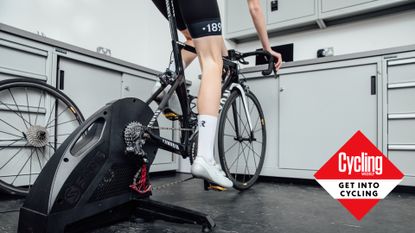
Poorly indexed gears can be one of the most frustrating things on a bike, but our step-by-step guide can show you how to adjust your bike gears to get them running smoothly.
Like your brakes, gears on your road bike groupset rely on correct adjustment and the smooth operation of cables to work well.
If you're buying a second hand bike as your first road bike or dusting off your old steed from the back of the garage, clunky gears are often an issue.
Although they seem complicated, getting your gears running properly is actually quite simple - continue reading to find out how to best go making these adjustments.
How do bike gears work?
Modern gears are indexed — that is to say, as you click the gear lever the front or rear derailleur puts the chain onto the corresponding sprocket or ring. It should do this effortlessly and without any fuss.
It should not go into a different gear position nor should it slip into another gear as you pedal along.
When the gears are working well you cannot shift gear past either the largest or the smallest sprocket or chainring.
Incorrect derailleur adjustment may not sound as dangerous as ineffective brakes, but having a derailleur slip into your spokes, having a chain come off the front chainring, or having your gears slip can potentially result in an accident.
To set-up or adjust your gears you'll need a small Philips screwdriver and an Allen or Hex key set - the best multi-tools should have you covered if you don't have a dedicated set of Allen keys.
Before you start working on your gears you'll want to ensure that your gear cables are running smoothly. If the cables are old or dirty they may not move freely and this will impact on your ability to adjust your gears effectively. It can also lead to confusion, as you may think that you need to adjust the tension on your cable, when it fact it's movement is impaired by grime.
If you're in doubt it's worth replacing both the inner gear cable and outer housing before you start.
Adjusting the rear derailleur
Before you start this process you'll want to check that your derailleur hanger is straight. This is the part that the rear derailleur attaches on to. If it's misaligned you'll struggle to correctly index your gears no matter how hard you try.
It's unlikely that you'll have a derailleur alignment tool at home so you'll need to visit a bike shop to get this checked out - the worst case scenario will require a replacement hanger, which is relatively inexpensive, however many hangers can be carefully bent back into alignment using the aforementioned tool.
Step 1
Put the gear lever into the top gear, turn the pedals and allow the chain to go onto the smallest sprocket on the cassette. If there is a barrel adjuster on the gear lever body, or the derailleur body, screw it almost all the way in (clockwise).

Step 2
Undo the cable-securing bolt or clamp on the derailleur and move the cable out of the way.
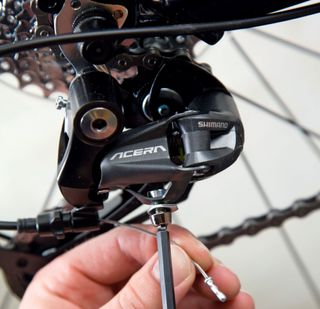
Step 3
Turn the pedals while using your other hand to manually push the rear derailleur in towards the rear wheel. Be careful not to catch your fingers in the spokes as you do this.
If the derailleur’s low limit screw is correctly adjusted, the chain will only travel onto the largest sprocket and go no further. The low limit screw impacts the derailleur's range of motion and will sometimes be marked with a 'L' on the derailleur body. It does not however make it move, this is the job of the cable and the spring located in the mech itself.
Step 4
If it goes beyond that sprocket and falls into the spokes, turn the derailleur's low limit screw in (clockwise) and repeat step three. If the chain does not sit comfortably on the biggest sprocket, unscrew the adjusting screw a little and try again.
Working in quarter turns of the limit screws will allow you to fine tune the position so it allows the chain to shift onto the sprocket but no further. You can use the pulley wheel of the derailleur as a visual reference, making sure that it lines up with the largest sprocket.
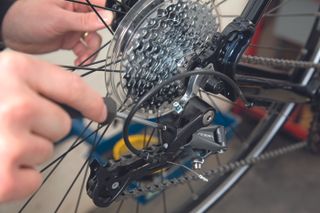
Step 5
Once you’re happy with that, allow the derailleur’s spring to push the derailleur outwards onto the smallest sprocket.
Again if the chain comes off, or does not sit properly on the smallest sprocket, turn the other adjusting screw - the high limit screw (sometimes marked with a 'H') - to move the derailleur’s position.
Ideally you'll want the top pulley wheel of the derailleur to line up with the outer edge of the smallest sprocket.
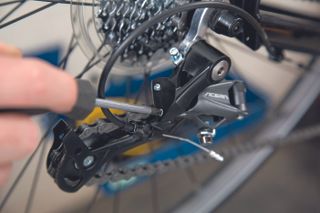
Step 6
When the derailleur’s travel goes comfortably between the high and low sprockets on the cassette, refit the gear cable, pull through any slack and then do up the clamp to secure the cable.
Step 7
Using the gear lever, go through all the gears several times. If the derailleur is slow to go into the lower gears (the larger sprockets on the cassette) unscrew the barrel adjuster on the derailleur body. This adds tension to the cable.
Once it's shifting into the lower gears you can make micro adjustments on the barrel adjuster to fine tune. Your ears are your best guide here - if the chain sounds like its rubbing on the next sprocket adjust accordingly until the noise is reduced and the chain runs smoothly.
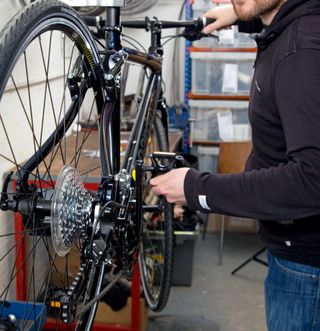
If it is slow to go into the higher gears, screw in the barrel adjuster to reduce tension on the cable - this should have the effect of allowing the derailleur and thus the chain to move down on to the smaller sprockets.
As with before, listen to hear if the chain is rubbing against another sprocket and turn the barrel adjuster in small increments until the sound is reduced.
Re-check that all the securing bolts are tight and go for a gentle test ride. You may find that you'll need to make some minor adjustments again to fine tune the shifting.
Adjusting the front derailleur
Step 1
Put the gear lever into the lowest gear, and if there is a barrel adjuster on the gear lever body (or sometimes on the gear cable itself, known as an inline barrel adjuster), screw it almost all the way in. Undo the cable-securing bolt or clamp on the operating lever of the derailleur and move the cable out of the way.

Step 2
Check that the front derailleur is parallel to the chainring, and that there is a gap of 1-2mm between the top of the largest chainring and the bottom of the outer plate of the front derailleur.
If not, loosen the fixing clamp and realign the derailleur.
If you're using a SRAM Yaw front derailleur, where the front of the cage moves in and out further than the tail does, it will require a different set-up and you should consult SRAM's instructions on how to do this correctly.

Step 3
With the chain on the biggest sprocket at the rear, adjust the 'inner' or low limit screw so that when the chain is on the smallest chainring there's about a small gap, around 1mm, between the chain and the inner cage plate. If the chain is rubbing on the plate, adjust the screw until the rubbing stops and there is a visible gap of 1mm.

Step 4
Now with the chain on the smallest sprocket on the rear cassette, pedal the bike with one hand and pull the front derailleur so that the chain goes onto the largest chainring at the front.
You achieve this by screwing or unscrewing the ‘outer’ or high limit adjusting screw on the derailleur body. Again, you'll want only a small gap - about 1mm - between the chain and the outer cage plate. If the chain is rubbing on the plate, adjust the high screw until there is a visible 1mm gap.

Step 5
Let the derailleur return to its position over the smallest chain ring. Refit the cable, and tighten the securing bolt. When reattaching the cable it's important that it's routed and clamped correctly. If not, this can restrict the movement of the derailleur. As the cable routing and clamping position varies from one derailleur to the next it's worth checking the brand's instructions.
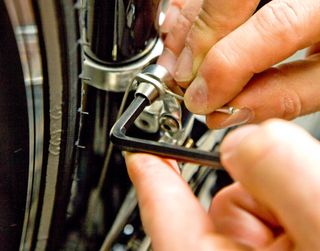
Step 6
With the bike off the ground, and the chain now on the largest sprocket at the back, test the front derailleur by moving the chain between the smallest and next chainring using the gear lever.
Do this with the crank arm at 12 o’clock, 3 o’clock, 6 o’clock and 9 o’clock, so that any slight bend in the chainring becomes apparent. If the chain falls off the smaller chainring, adjust the ‘inner’ low limit screw so that the derailleur cannot move as far inboard.
When you’ve done this successfully, and with the gear lever back in ‘1’ or ‘low’ and the chain on the small chainring, loosen the cable securing bolt and take up the slack on the cable.
Step 7
Put the chain onto the smallest cog on the rear cassette. If you have a three-ring crankset, repeat the procedure above, this time going from the middle chainring to the biggest chainring.
If the chain falls off the front of the chainring, adjust the high limit derailleur screw, so the derailleur does not move quite so far out.
Step 8
If you find that the derailleur is slow changing up from small to big chainring, unscrew the cable adjuster on the gear lever body a little to add some tension to the cable.
At this point you'll also want to check that the chain is still able to move smoothly back down on to the smaller chainring. If not, you've probably added too much tension to the cable via the barrel adjuster. Simply make a few quarter turns on the adjuster until the chain shifts quickly onto the small chainring.
Recheck that all the securing bolts are tight and go for a gentle test ride. As with the rear derailleur it's likely that you may need to make some further, smaller, adjustments based on the feedback from your ride.

Thank you for reading 20 articles this month* Join now for unlimited access
Enjoy your first month for just £1 / $1 / €1
*Read 5 free articles per month without a subscription

Join now for unlimited access
Try first month for just £1 / $1 / €1
Get The Leadout Newsletter
The latest race content, interviews, features, reviews and expert buying guides, direct to your inbox!
Luke Friend has worked as a writer, editor and copywriter for twenty five years. Across books, magazines and websites, he's covered a broad range of topics for a range of clients including Major League Baseball, the National Trust and the NHS. He has an MA in Professional Writing from Falmouth University and is a qualified bicycle mechanic. He has been a cycling enthusiast from an early age, partly due to watching the Tour de France on TV. He's a keen follower of bike racing to this day as well as a regular road and gravel rider.
-
 Why do coffee and cycling go together so well? An investigation
Why do coffee and cycling go together so well? An investigationCoffee connoisseur Adam Becket delves into the storied yet mysterious relationship between cycling and the original energy drink
By Adam Becket Published
-
 'I’ve been battered by the cycling community for wearing normal clothes, not to mention not using a helmet' - Chris Boardman on riding for utility, and sport
'I’ve been battered by the cycling community for wearing normal clothes, not to mention not using a helmet' - Chris Boardman on riding for utility, and sportChris Boardman and author Tom Babin both advocate shifting the mindset away from tribalistic 'sport cycling' and 'commute cycling' to a more rounded approach
By Hannah Bussey Published
-
 11 ways to increase your average speed: training tips and instant gains
11 ways to increase your average speed: training tips and instant gainsWhen looked at over a period of months, your average speed can tell you a great deal about how you’re improving as a cyclist. Here’s some top tips to get your mean looking meaner
By Hannah Reynolds Published
-
 Kickstart your riding with our cycling training plan for beginners
Kickstart your riding with our cycling training plan for beginnersReady to get fit and healthy through cycling? Then this is the plan for you! In partnership with Alzheimer's Research UK
By Anna Marie Abram Published
-
 Nine ways to make yourself and your bike more aero for free
Nine ways to make yourself and your bike more aero for freeHere are our top tips for free speed: all you need are a few simple adjustments
By Zach Nehr Published
-
 Save money, fuel better: 20 ways to slash your cycling nutrition costs
Save money, fuel better: 20 ways to slash your cycling nutrition costsWith food prices soaring, it’s getting ever more expensive to sate a cyclist’s appetite. Here’s a nutritionists’ guide on how to cut your fuelling bill – without compromising on health or cycling performance
By Anita Bean Last updated
-
 Five free fitness features on Garmin Connect that cyclists should be taking advantage of
Five free fitness features on Garmin Connect that cyclists should be taking advantage ofHere’s how to make the most of the training software which comes free with Garmin’s cycling computers and smartwatches
By Andy Turner Last updated
-
 Why pay for Zwift when you can ride on MyWhoosh for free?
Why pay for Zwift when you can ride on MyWhoosh for free?With group rides, races, multiple worlds, training plans and workouts, this ad-supported start-up has most bases covered
By Stefan Abram Published
-
 All the essentials to get started cycling indoors (on a budget – or not)
All the essentials to get started cycling indoors (on a budget – or not)Indoor cycling is a fast, efficient way to get fit, here is all you need to get started and beyond
By Luke Friend Published
-
 Gain without pain - here’s the cost-free aero test that every cyclist should try
Gain without pain - here’s the cost-free aero test that every cyclist should tryWhy toil away at hard intervals when you could make bigger gains by effortlessly tweaking your position? We head toa racetrack in search of cost-free aero improvements
By Tom Epton Last updated